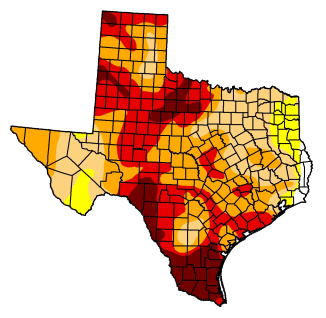Drought Concerns in Bell County
Clearwater UWCD is concerned about the deteriorate conditions of the Trinity and Edwards Aquifers in Bell County due to the drought.
 We have been monitoring both the Trinity and Edwards BFZ Aquifers for more than six years and have great concern that the epic drought conditions have not subsided and conditions could possible get worse in the months to come. We measure the health of the Edwards Aquifer in three different ways and with two of those being triggers for drought awareness. The first trigger is rainfall measurement based on a 365 day running total. The second being the spring flow measurements at the complex of springs in downtown Salado that contribute to the Salado Creek as they diffuse water from the aquifer into the creek. We also monitor more than seven wells and have fourteen wells at our disposal to measure static water levels and drawdown.
We have been monitoring both the Trinity and Edwards BFZ Aquifers for more than six years and have great concern that the epic drought conditions have not subsided and conditions could possible get worse in the months to come. We measure the health of the Edwards Aquifer in three different ways and with two of those being triggers for drought awareness. The first trigger is rainfall measurement based on a 365 day running total. The second being the spring flow measurements at the complex of springs in downtown Salado that contribute to the Salado Creek as they diffuse water from the aquifer into the creek. We also monitor more than seven wells and have fourteen wells at our disposal to measure static water levels and drawdown.
We monitor the Trinity Aquifer in a similar fashion by first monitoring the lack of rainfall under the same process termed PDI or Precipitation Deficit Index. We know as of April 29, 2013 we had only an average of 19.81 inches of rain in the last 365 days. This is a major indication of the health of the identified region we call the recharge of area of the Trinity, and is represented by all of Bell County and 50 additional miles to the west and northwest counties. The second and most troubling measure of the health of the Trinity is the drawdown being experience in wells across the western half of Bell County. These wells continue to express drawdown in the layer of the aquifer known as the Middle Trinity. This layer is somewhat deeper than Edwards wells yet still affordable to construct a well for domestic purposes. Owners of these wells are being encouraged to limit water use by many methods yet the first and most important is landscape use. Yes we want a green lawn, but we also need water for drinking and cooking.
We fear that with homeowners, businesses and permit holders always increasing their historical use of water in late spring and summer months, thus we could see tremendous decline in water storage and even springflow by late summer. The only way to see an improvement is to ask for water conservation by reducing our use for landscape purposes. We currently do not have a mandatory drought management plan, yet we have a robust system in place to encourage water conservation in these extremely dry times. (see below recommendations)
The district has in place a stream flow gauge system that measures the Salado Springs Complex of six known springs in the Salado Downtown Proper. The measurement is only one method of interpreting the health and storage capacity of the Edwards.
The past and present Board of Directors have funded three very robust methods to measure the health of Edwards Aquifer as well as the springs. The other two methods are our rainfall deficit measurement, that simply calculates what percent of annual rainfall are we above or below the average of 33 inches per year. The difference in our system compared to others who analyze rainfall averages by calendar year and month, is that we know at any given day how far behind are we based on the 365 day running total from the current calendar day. Today we are have only received 60.85% of the expected rainfall in the last 365 days (20.08 inches) in the identified recharge area of the northern segment of the Edwards BFZ Aquifer. This is known as the Precipitation Deficit Index (PDI) which is the measure of percent( %) of annual expectations. This index has never risen above 68% in the last 2 ½ years. We are dry and getting dryer!
The only positive measurement is that our static water level measurements in Edwards monitor wells across the Salado Water Shed document that excessive decline is not occurring at this time. We believe it’s because people respect the need for conservation and are aware we need to avoid excessive usage. This is not the case in the Trinity Monitor Wells, we are seeing a steady decline, thus conservation is warranted by those private well owners as well as our Trinity permit holders.
The message is the same for all well users in Clearwater’s jurisdiction, “Conserve now while you can have an impact”.
Edwards BFZ Aquifer Status Report

Trinity Aquifer Status Report

Stage 2 Concern – 20% reduction is recommended:
Continue or increase voluntary reduction in various uses.
Check for and correct all plumbing leaks.
Re-use or re-circulate water whenever possible.
No filling of ponds, lakes, tanks, reservoirs, swimming pools or other surface impoundments for holding water that have a total capacity of more than 50,000 gallons, except for public water supply systems. Public water supply systems are encouraged to implement measures to achieve a 20% reduction in water usage.
Limit watering of landscape (lawns, trees, shrubs, etc.) to only once every 5 to 7 days. Agriculture and horticulture operations are exempted from this measure but are encouraged to reduce tree, plant, and crop watering by 20%.
Only water landscape at night between the hours of 7 pm and 7 am.
Keep swimming pools, landscape or decorative ponds and fountains covered (if possible), re-circulate water, and wait 5 to 7 days to refill.
Wash vehicles at car wash only as needed.
Do not wash buildings, driveways, streets, patios, or other outdoor surfaces except as required for human or animal health and safety needs, or for fire prevention.
Water livestock in leak-proof troughs as much as practical.
